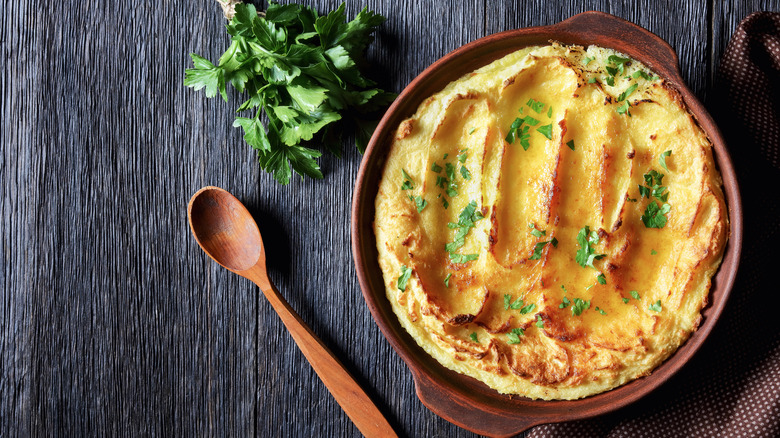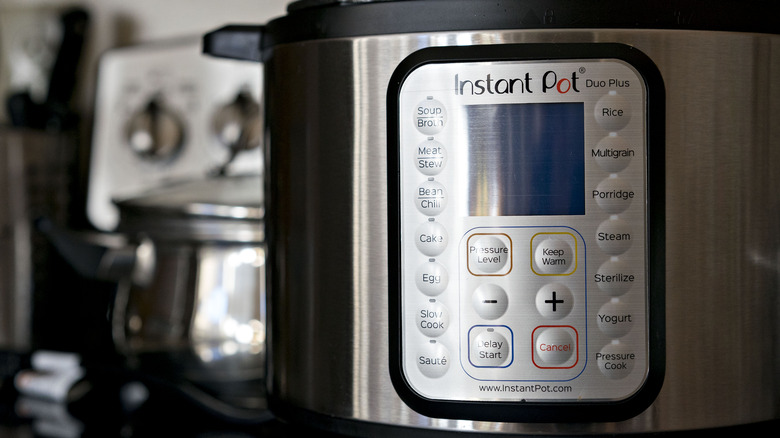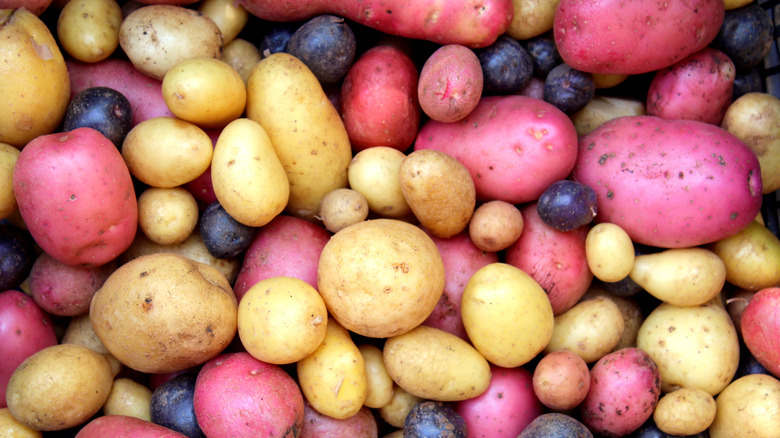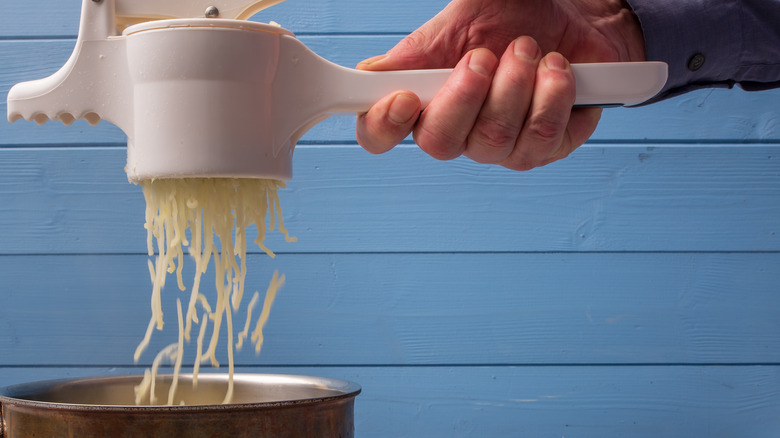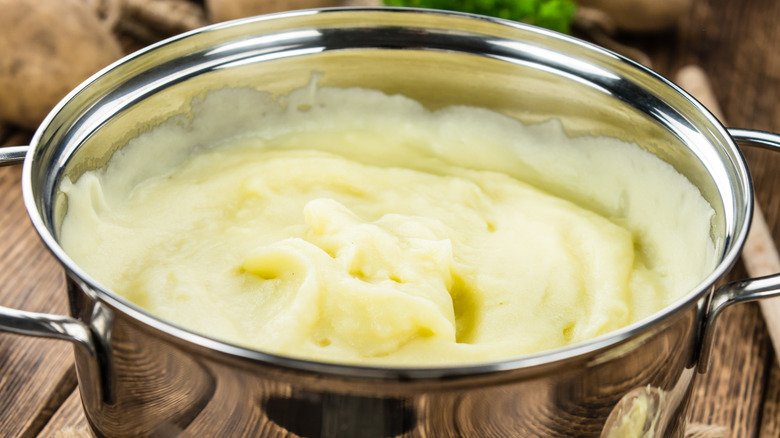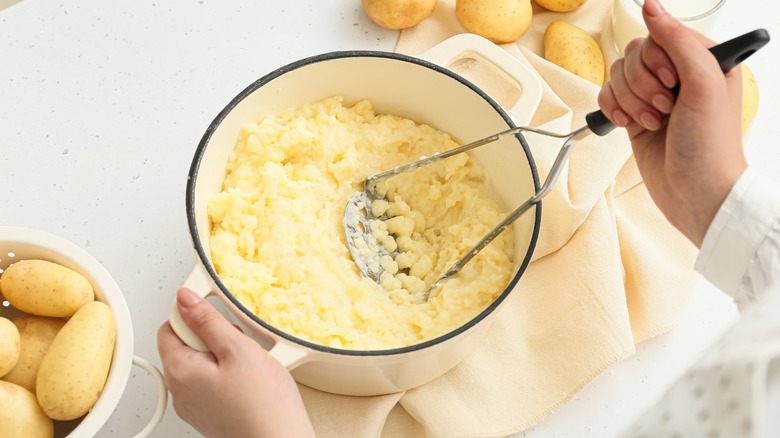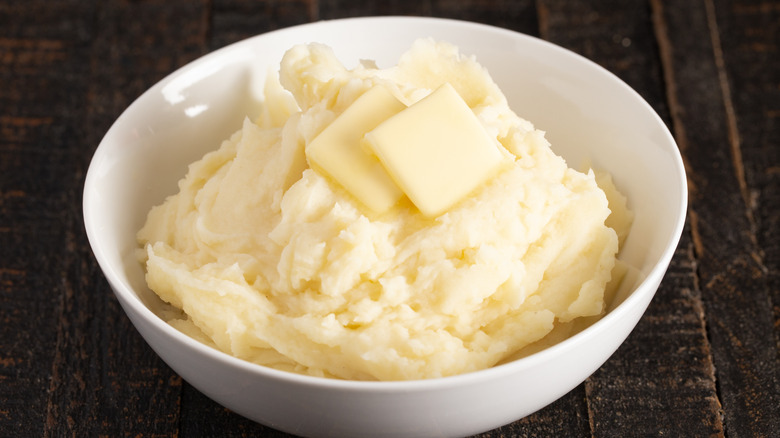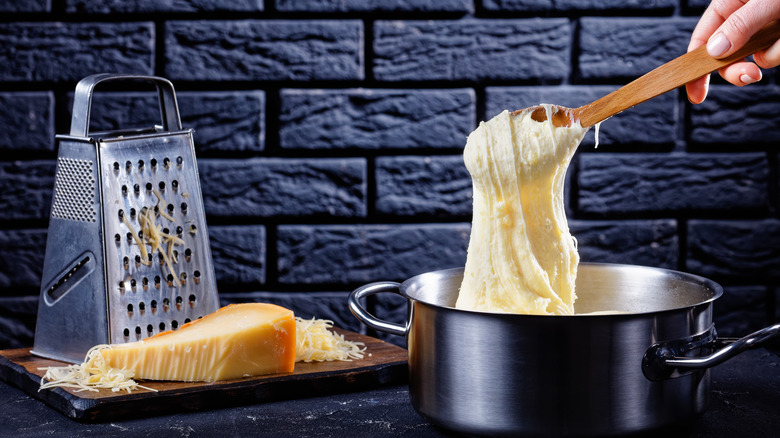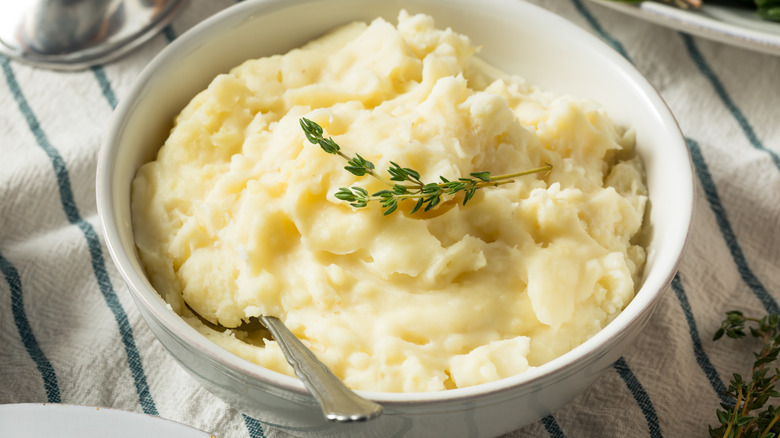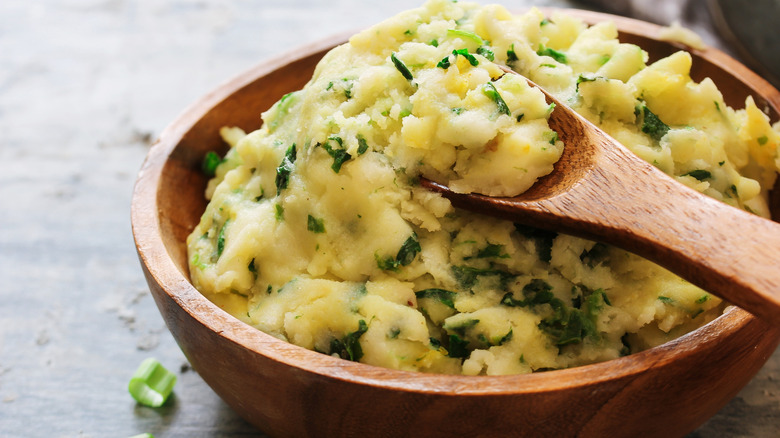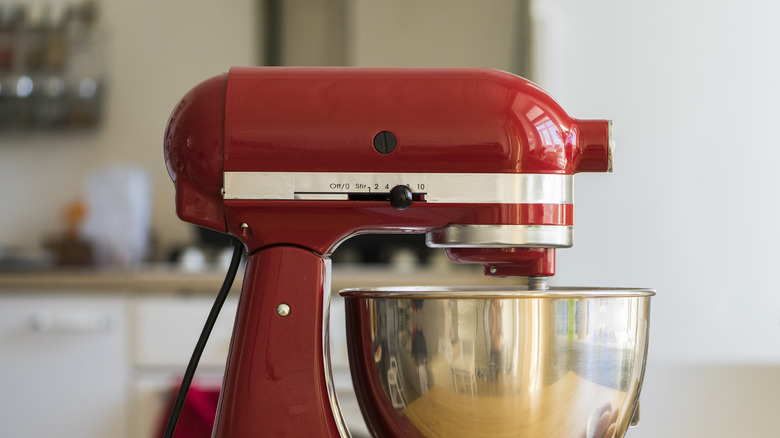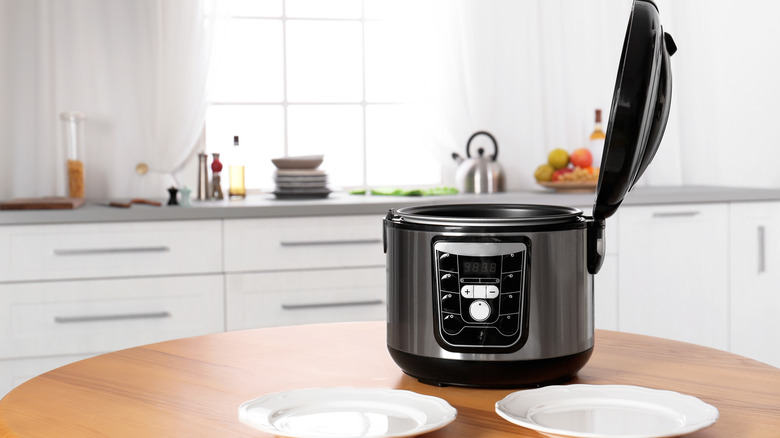13 Methods Of Making Mashed Potatoes, Explained
There are few dishes as cherished as mashed potatoes. Something about the soft texture and cloud-like spoonfuls of buttery starch has captivated our hearts for what seems like forever. Mashed potatoes are both casual and decadent, like this version with meaty chunks of lobster and this version for casual weeknight dinner. This dish is so versatile; it can transform into anything you need it to be.
But because of its chameleon-like qualities, the methods of making mashed potatoes are just as diverse. What's the difference between a masher and a ricer? Which spud makes the best mash? How much butter do I really need?
To get to the bottom of this, we've compiled a list of various mashed potato-making methods and did our best to explain the differences to you. Most of the time, the answer lies in your answer to the age-old conflict: chunky mash, or silky and smooth mash. We all like something a little different when it comes to this dish's texture, so let that be your guide here!
Bake your mashed potatoes
If there's one bad thing about mashed potatoes — and trust us, it's hard to find one — it's that they don't really last, nor can they optimally be prepared ahead of time. The potatoes resolidify and with all the gorgeous fats mixed in (butter, milk, cheese), they become gluey. It's not like mashed potatoes are the most involved dish out there, but they certainly take time to boil, mash, and prepare. When it comes to the holidays, making as much as you can the day before really is a lifesaver. So is there any hope for an ahead of time mashed dish?
Lauren Rothman argues that yes, there is. Baking your mashed potatoes is your best line of defense. Otherwise known as a potato casserole, baked mashed potatoes require folding a few ingredients together with the already mashed potatoes, baking them once the day before, and then popping them into the oven 20 minutes before you're ready. While the result may not be the silky, pourable variety some people love, they will be warm and delicious; kept from drying out.
Try an instant pot
The most time-consuming part of making mashed potatoes is boiling the water and patiently waiting for your potatoes to be fork tender. Using an instant pot is a way to keep your dinner simple and hassle-free. Not to mention that it takes away the painstaking, tortuous aspect of waiting for your water to boil (a watched pot may never boil, but we think an intense stare does help).
Preparing your potatoes in a pressure cooker or instant pot only takes 20 minutes total. That's how long it takes to simply cook the potatoes normally. In essence, you're turning the instant pot into a steamer. Place a cup of water and salt inside the bowl, stir until dissolved, and then lower a steamer basket in. This will hold your potatoes, which will cook under high pressure for only eight minutes. Take them out, mash with a fork, masher, or ricer, add your butter, milk, chives, what have you, and voila! Mashed potatoes in record time.
Use a variety of potatoes
This should be a no-brainer. Each type of potato brings something different to the stage (or in this case bowl). Trying a variety of potatoes brings out a cacophony of textures and flavors. Russet potatoes — or your typical large potatoes used for most dishes — are heavy with starch. This is actually why some folks don't like them, especially when it comes to mashed potatoes. However, russets provide a dose of sustenance and heartiness to the dish. Yukon gold potatoes, or those precious nuggets with thin skin, won't get water logged and stay true to the texture. Both Yukon and red potatoes add a can't-miss creaminess. Just make sure to balance out those textures in the final dish!
The potatoes you use in mashed potatoes matter. Texture and taste can change rapidly depending on which you use, so be sure to keep those factors in mind when planning your next mashed potatoes dish.
Run it through a ricer
If you are team smooth mashed potatoes, this method of making them is for you. We will never be caught saying which version is better, but we will say silky smooth mashed potatoes are definitely more time-consuming to achieve. The ricer is your solution to this. This kitchen utensil is pretty well known, but if you're unaware, it's a contraption with small holes that you either push or stir boiled potatoes through. Your resulting mash is rid of any lumps for a silky final dish. When using a ricer, though, you want to make sure each potato is completely cooked through and tender. Otherwise, you could break the device or cause a backup.
The ricer isn't for potatoes alone, and you can use it throughout the entire process if you use garlic confit, room temperature butter, or other soft ingredients. And while you could maybe get the same or similar effect by using a sieve or fine-mesh strainer, a ricer requires less brute strength and time overall.
Add baking powder
This method of making mashed potatoes is all about the fluff. Baking powder acts as a raising agent in cookies, cakes, and bread. So why wouldn't it do the same with your mashed potatoes? This ingredient is one secret to cloud-like, pillowy spuds that will dance on your tongue.
Adding baking powder is simple, but the effect is irreplaceable. Even the starchiest of spuds can be transformed by adding just the right amount. However, that's the one downside. The right amount is going to differ depending on what potatoes you're using and how many additional fats are in your recipe. What you should see in the making process are bubbles once the baking powder is added. Other than that, all the advice we can really give you is to experiment and behold. Unlike baking soda, you aren't at risk of a salty and bitter taste by adding too much. The problem you might run into is not adding enough baking powder.
Get out your masher
Perhaps the first method we think of when we think of mashed potatoes is the masher. They come in a few different styles: either with small holes at one end or a lightbulb coil-looking design. It requires some arm strength, that's for sure, but it is as simple as you can get when it comes to preparing mashed potatoes. And if you've got some aggression to take out — maybe your dog got in the trash again or that piece of clothing you need tomorrow still hasn't arrived yet — then using this method of preparation is great for many reasons.
While this option is ideal for its simplicity, the masher will leave you with a chunkier texture. This is fine, of course, if that's the mashed potato texture you're striving for. If you're on team silky smooth, on the other hand, it's going to take a lot of force and repetitive motion to get you there, no matter how boiled your potatoes are.
Don't doubt powdered potatoes
When it comes to getting delicious food onto the table, we're not in any position to judge. Life is busy; maybe you're working all day before being stuck in commuter traffic, only to finally arrive home and be met with hungry mouths desperate to be fed. At that point, dinner becomes more of a necessity than a 5-star culinary experience. Mashed potatoes are the perfect side for many reasons, a big one being the sustenance they provide to any meal. But, they can take a lot of arm strength, and if you're in a pinch, the instant mash will do. It always does.
There are fancier versions out there now, and you can certainly spice up the mix, but the most basic of instant or powdered mashed potatoes simply require the package and hot water or milk. Adding butter is a great way to build body in the potatoes, but it isn't necessary. Ultimately, it's up to you and how much energy you have. At the end of the day, instant mashed potatoes are reliable and efficient.
Make the French dish, Pomme Aligot
"I don't like cheese with my potatoes," said no one ever. This recipe went viral a few years ago for being addictively satisfying to watch. The French hit the nail on the head of rich flavors when they made this one. Pulling like melted mozzarella, this cheese and potato dish is a must.
Pommes Aligot is the name of the game here. There's no real English translation of this name beyond "cheesy potato dish," and we're not complaining. To make it, you are going to need an ample amount of butter, cream, and cheese. The dish begins like all other mashed potato recipes: boil the vegetable until fork tender. Because this dish's ideal consistency is smooth, you will also need to ditch the masher or fork for a ricer. After that, bring the potatoes back to the stove and mix in your fats. Then keep stirring until the texture resembles melted mozzarella. It's out of this world delicious.
Mash with a fork
For folks who like their potatoes chunky for added textural play, using a fork is a great option if you're in a pinch and find yourself without a potato masher. This humble instrument, found in most — if not all — kitchens, can get the job done. Mind you, you'll want to use something sturdy, rather than a plastic fork leftover from that picnic you had a few months ago. A plastic fork will snap in no time, even with the softest of potatoes.
If you're ready to commit, find the strongest fork in your kitchen and maybe a partner you can tap in when the hand cramp starts. But, for the most part, this is a viable method, as explained in this smashed potatoes recipe. You're just going to want to cook your potatoes for a long time until they are fork tender (get it?), which will just make everything easier. You may also consider peeling them before boiling for an easier time mashing with a fork. Otherwise, use your pointer finger to push down on the fork, or if you're using a powdered mix, use the fork as a whisk.
Add cabbage like the Irish
While we're not sure how healthy mashed potatoes can be (nor do we think you need to make them as such), you can bring some greens into the mix by taking a cue from the Irish. The traditional Irish colcannon dish combines cabbage — or any green you like, including kale and swiss chard — to combine your starch and vegetable sides into one delicious meal.
To make this dish, boil the potatoes until tender. In another pan, sautée your vegetable of choice with some green onions. When the potatoes are ready, put them in a pot with the hot cabbage and get to mashing. You'll of course want to add the typical offenders of milk, cream, butter, or all three to get a creamy texture. The added vegetables bring a bit of brightness to the show, but you still won't want to forget salt and pepper. This is a great way to make mashed potatoes new again and trick your kids (or partners) into eating their greens.
Mash in a stand mixer
This might seem like a no-brainer, but before grabbing your stand mixer, know that the resulting mashed potatoes will be denser and smoother than simply running them through a ricer or masher. So for those of you who like a creamy mash without chunks of potato, try this method out!
The stand mixer method still requires you to boil the potatoes before, but it totally takes out the physical work involved. That means this is a great option for folks who are unable to exert that type of energy or have certain mobility limitations. You'll want to use the paddle attachment for the best outcome. But that's it in terms of personal involvement from here on out. Simply chuck the tender spuds inside the basin, carefully lower the stand, and let it whip. This method is more than convenient, however. Using a stand mixer can also leave the potatoes' starch more intact, which when combined with the butter and dairy, it results in that extra dense texture. You will also find a more butter-forward taste — yum!
Add even more butter
Perhaps this one goes without saying. Can you even imagine mashed potatoes without butter mixed in? Not really. But perhaps you're not considering just how far you can go with this delicious fat. Joël Robuchon, the late French chef, was deeply recognized for his purée de pomme. This is a super-rich, silky smooth dish that translates to pureed potatoes. To get that right consistency, Robuchon used a 2-to-1 ratio. So that's a half stick of butter for every pound of potatoes. While that might sound like a lot of potato for your butter, remember that these are hefty vegetables. And one pound really equals out to about two russet potatoes.
We're not saying you have to go this far — maybe it's worth a try on a special occasion — but we hope this information can liberate your butter-adding tendencies. If there isn't enough fat in the dish, no amount of mashing, ricing, or forking will get you that silky smooth consistency.
Use a slow-cooker
Using a slow-cooker is perfect for those of you who want to set it and forget it. Let's face it, the hardest part about making mashed potatoes is the amount of attention they require in that beginning stage. And, well, in the end. There's really no part of the process that allows you to go fold some laundry or scroll through Instagram while leaning against the counter. You have to get the water boiling, properly salt it, wait for the potatoes to reach fork tender, pull them out, add in butter and milk, then get to smashing.
Using a slow-cooker means you don't have to boil them at all. And they'll be so soft, with barely any mashing actually required. Another great bonus to making mashed potatoes in a slow-cooker is the much-reduced amount of mess afterward. Everything is confined to one bowl, where both the mashing and boiling are done. This means fewer plates, sure, but also the high walls of slow-cookers keep the flying potato flesh inside.

